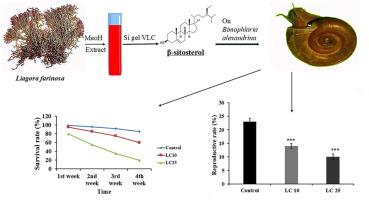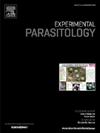β-sitosterol: A novel molluscicidal agent from Liagora farinosa against Biomphalaria alexandrina snails with computational insights into its interaction with the retinoid X Receptor
IF 1.6
4区 医学
Q3 PARASITOLOGY
引用次数: 0
Abstract
Schistosomiasis is a tropical parasitic disease that presents significant public health concerns, occurring in both acute and chronic forms. In Egypt, the freshwater snail Biomphalaria alexandrina is the intermediate host of Schistosoma mansoni. This study evaluated the molluscicidal potential of β-sitosterol, isolated from the marine red alga Liagora farinosa, along with its methanolic extract, against B. alexandrina. Bioassay results demonstrated potent molluscicidal activity, with the methanolic extract exhibiting LC50 and LC90 values of 187.5 mg/L and 231.8 mg/L, respectively, and β-sitosterol showing enhanced potency with LC50 and LC90 values of 36.1 mg/L and 41.7 mg/L after 48 h of exposure. Sublethal concentrations of β-sitosterol significantly reduced snail survival and reproductive rates. Biochemical analyses revealed a marked decrease in total antioxidant capacity and superoxide dismutase (SOD) activity, accompanied by increased levels of malondialdehyde (MDA) and reduced glutathione (GSH), indicating oxidative stress. Histopathological examination of treated snails showed extensive damage in the digestive and hermaphrodite glands, including vacuolation, cellular rupture, and degeneration of reproductive cells. Ultrastructural alterations such as nuclear disintegration, cytoplasmic vacuolation, residual body accumulation, and microvilli loss were also observed. Computational studies suggested retinoid X receptor to be a plausible target for β-sitosterol in its molluscicidal activity. These findings highlight the potential of L. farinosa extracts and β-sitosterol as bioactive agents for Schistosoma mansoni intermediate host. However, further research is required to assess their impact on non-target aquatic organisms.

β-谷甾醇:一种新型杀螺剂,利用计算方法研究其与类视黄醇X受体的相互作用。
血吸虫病是一种引起重大公共卫生关切的热带寄生虫病,有急性和慢性两种形式。在埃及,淡水蜗牛Biomphalaria alexandrina是曼氏血吸虫的中间宿主。本研究评价了从海洋红藻Liagora farinosa中分离得到的β-谷甾醇及其甲醇提取物对绿僵菌的杀软体动物潜能。生物测定结果表明,乙醇提取物的LC50和LC90分别为187.5 mg/L和231.8 mg/L, β-谷甾醇的LC50和LC90分别为36.1 mg/L和41.7 mg/L,具有较强的杀螺活性。亚致死浓度的β-谷甾醇显著降低了蜗牛的存活率和繁殖率。生化分析显示,总抗氧化能力和超氧化物歧化酶(SOD)活性显著降低,丙二醛(MDA)和谷胱甘肽(GSH)水平升高,表明氧化应激。处理过的蜗牛的组织病理学检查显示消化腺和雌雄同体腺的广泛损伤,包括空泡化、细胞破裂和生殖细胞变性。超微结构的改变,如核解体、细胞质空泡化、残体堆积和微绒毛丢失也被观察到。计算研究表明,类维甲酸X受体可能是β-谷甾醇灭螺活性的一个合理靶点。这些研究结果表明,糠草提取物和β-谷甾醇具有作为曼氏血吸虫中间宿主生物活性物质的潜力。然而,需要进一步的研究来评估它们对非目标水生生物的影响。
本文章由计算机程序翻译,如有差异,请以英文原文为准。
求助全文
约1分钟内获得全文
求助全文
来源期刊

Experimental parasitology
医学-寄生虫学
CiteScore
3.10
自引率
4.80%
发文量
160
审稿时长
3 months
期刊介绍:
Experimental Parasitology emphasizes modern approaches to parasitology, including molecular biology and immunology. The journal features original research papers on the physiological, metabolic, immunologic, biochemical, nutritional, and chemotherapeutic aspects of parasites and host-parasite relationships.
 求助内容:
求助内容: 应助结果提醒方式:
应助结果提醒方式:


